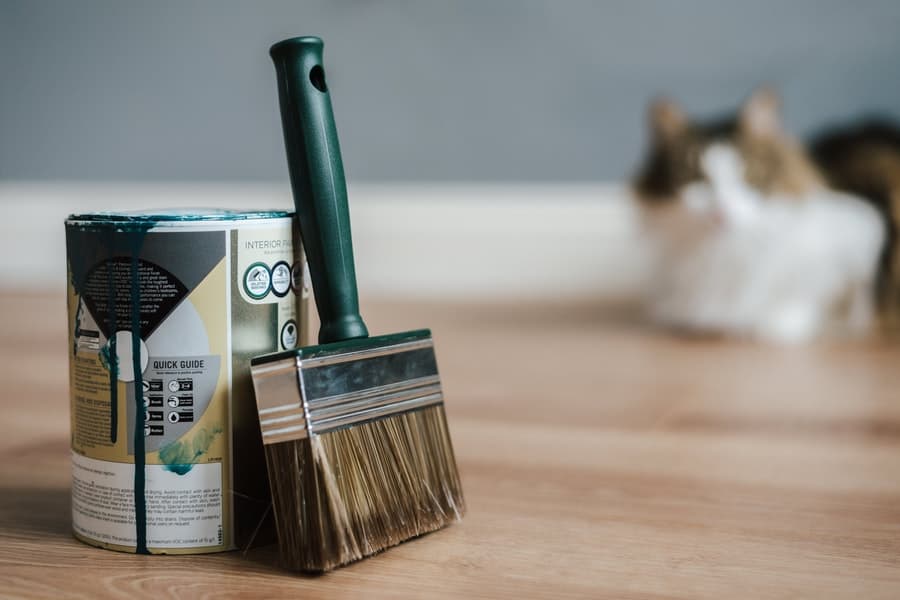When painting your home, you may find that you need to cover plastic items. While some plastics are paintable, others are not. If you attempt to paint a non-paintable plastic item, the result will be frustrating and messy. Paint will not only remain on the surface, but it also seeps into the cracks of the material as well as underneath it. To prevent this scenario from occurring, research which plastics are paintable before beginning your project. Doing so will save you time and money in the long run. If you have already stained your plastic or another non-paintable item with an unwanted coat of paint, there are ways to restore its original appearance once again. Keep reading to learn more about removing paint from plastic items and other surfaces efficiently and cost-effectively.
How To Remove Paint From Plastic
Vinegar
Vinegar has many uses and can be used to remove paint from plastic, wood, concrete, and more. It can even be used to remove rust and corrosion. It is, however, a mild acid so make sure to wear gloves, goggles, and an apron when working with it. To remove paint with vinegar, start by pouring undiluted white vinegar onto the paint stain. Let sit for 15-30 minutes. Next, you can scrub the stain with a soft-bristled toothbrush. Rinse and dry the plastic as soon as you finish scrubbing.
Baking Soda
Baking soda is another household item that can be used to remove paint from plastic. It is a mild abrasive that can be used to remove anything from old glue to crayon marks. Make sure to wear a pair of gloves when working with baking soda or any other abrasive cleaner to avoid cutting your hands. Start by sprinkling baking soda over the paint stain. Let sit for a few minutes, then sweep the baking soda into a dustpan and wipe the dust into the paint stain. Repeat until all of the paint is gone. You may also want to do this a few times to make sure that you get all of the paint out. Alternatively, you can mix baking soda with water and apply it with a sponge or rag.
Rubbing Alcohol
Rubbing alcohol specifically denatured alcohol, is another cleaning product that can be used to remove paint from plastic. Denatured alcohol is a low-grade version of isopropyl alcohol, a chemical compound that is commonly used in cleaning products. It is also flammable and toxic so make sure to use it in a well-ventilated area and wear gloves and eye protection. Put some rubbing alcohol on a cotton ball or rag and scrub the paint stain gently. You do not want to scrub too hard or you might end up damaging the plastic. Finish by wiping the area clean with water.
Dish Liquid and Shaving Foam
Dish liquid and shaving foam are cleaning products that can be used to remove paint from plastic. Both can be toxic, so make sure to use them in a well-ventilated area and wear gloves and eye protection. Start by sprinkling dish liquid or shaving foam over the paint stain. Let it sit for a few minutes, then wipe the stain into a dustpan with a sponge or rag. Finish by wiping the area clean with water.
Why You Should Remove Paint From Plastic?
It’s bad for your health
If you have read this far, it is likely that you have been affected by the issues surrounding removing paint from plastic. Unfortunately, there is another serious issue that you need to be aware of. Many of the paints that are used for decorating toys are extremely toxic. Some of them contain lead, which is a known neurotoxin that can affect the development of children. In fact, it can cause learning difficulties, behavioral disorders, developmental disorders, and even hearing and visual problems. Lead is particularly dangerous to infants and toddlers because they are more sensitive to the effects of toxins. This is because their bodies, nervous systems, and cognitive skills are still developing. If you have toys that were painted with toxic paints, you need to get rid of them immediately. If you have small children, especially babies, you need to be careful not to expose them to these toxic paints.
The paint is very difficult to remove
Unfortunately, in many cases, the paint is painted over the entire toy, so it is nearly impossible to remove it without damaging the toy. In many cases, the paint is baked into the plastic, so it can be difficult to remove even with strong solvents. In other cases, the paint is applied in a way that is almost impossible to remove. You can try scraping the paint off with a knife, but it may damage the toy. You can try scraping the paint off with a soft sponge, but that might not work either. The best option is to use a solvent to dissolve the paint. You can use turpentine, mineral spirits, acetone, or paint thinner. Be sure to test the solvent on a small, hidden area first to make sure it doesn’t damage the plastic. If the solvent doesn’t remove the paint, it might be possible to use a paint stripper.
Paint on plastic is very likely to crack and flake
The paint on plastic toys is very likely to crack and flake. It can peel off in large chunks or small flakes. In the best-case scenario, it will look very tacky, fail to cover the toy completely, and eventually peel off over time. In the worst-case scenario, it will be a safety hazard. The paint can flake off in the hands of small children and babies. It can create a choking hazard for infants, toddlers, and young children. You can try removing the paint with a solvent such as turpentine or paint thinner. You can also use a paint stripper, but that is often a long and messy process. In some cases, the best option is to leave the paint on the toy and try to cover it with another layer of paint. It will be very difficult to do a good job, and it won’t look as good as it did originally.
How To Remove Paint From Vinyl And Pvc?
- To remove paint from vinyl and PVC, you’ll need a solvent that can dissolve both the paint and the glue holding the material together.
- Lacquer thinner is an excellent choice for this job. Simply use a clean rag to apply the solvent to the surface of the vinyl, and then let it sit for a few minutes before scrubbing away the paint. If you are working with a large piece, you may want to consider using a paint remover like Goof Off.
- Simply spray or pour the solution onto the surface and then scrape off the paint with a putty knife or other scraper.
- Be sure to use a solvent that is appropriate for the vinyl or PVC material.
- Using a solvent that can dissolve both the glue and the paint may cause the material to separate.
How To Remove Paint From Polycarbonate?
- Polycarbonate can be found in a wide range of materials, including sports helmets, safety goggles, and some food storage containers. Therefore, it’s a good idea to know how to remove paint from polycarbonate if you’ve accidentally stained one of these items with paint.
- Aerosol paint removers that contain the solvent acetone work well on polycarbonate.
- Simply spray the solution onto the surface and leave it for a few minutes to penetrate the paint before scraping away the unwanted material.
- Make sure to wear gloves and a mask when working with this solvent.
How To Remove Paint From Abs And Nylon?
- ABS plastic and nylon are two other materials that can be stained with paint. To remove paint from ABS, you’ll need to use a solvent that can dissolve both the paint and the glue holding the two materials together. Acetone is a good choice for this job.
- Aerosol paint removers that contain acetone are designed to remove paint from all different types of plastic. Simply spray or pour the solution onto the surface and then scrape away the paint with a putty knife or other scraper.
- You can also pour the solvent into a clean, empty spray bottle and then use a paintbrush to scrub the surface clean.
- If you’re working with a large ABS or nylon surface, you may want to consider using a paint stripper. Paint strippers are designed to dissolve the glue and remove the paint from the surface completely.
Conclusion
One of the most frustrating things a painter can experience is ruining an otherwise pristine piece of furniture. However, it’s important to remember that not every surface can be painted. Plastic, vinyl, and other synthetic materials are more susceptible to damage when exposed to paint. If you find that you’ve stained one of these items with paint, don’t panic. Simply choose the appropriate solvent for your situation and follow the instructions carefully. Soon enough, you’ll be able to enjoy your furniture and decorations once again without worrying about ruining them with paint.







